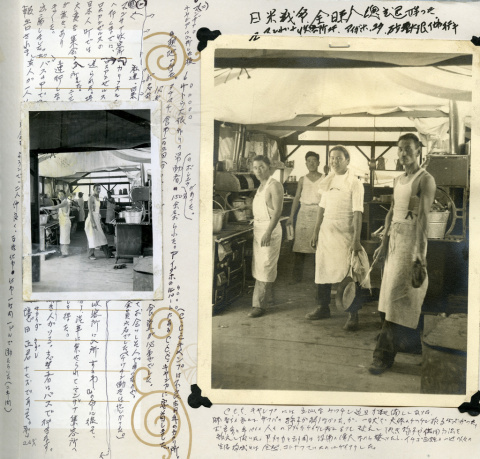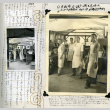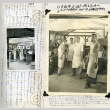George Naohara's handwritten annotations
PARTNER
CSU Japanese American History Digitization Project
Visit partner
OBJECT ID
ddr-csujad-38-2 (CSUJAD Local ID: nao_01_004, CSUJAD Project ID: csudh_nao_0165)
PARENT COLLECTION
CSU Dominguez Hills George and Mitzi Naohara Papers
DESCRIPTION
English translations of handwritten annotations from "George Naohara photo album" (csudh_nao_0001), page 4: [Left] Several meetings were held in Little Tokyo, Los Angeles, California, prior to moving to the Manzanar incarceration camp in California. I attended those meetings. What was announced was that all Japanese Americans residing in California and the West Coast should move to “War Relocation Centers” and we, Japanese Americans, complied with the decision made by the U.S. government. We gathered at the Merynoll School in Los Angeles. We were directed to get on a train at the Union Station and sent to the Manzanar incarceration camp. We were allowed to bring one suitcase and one gallon of water. I was incarcerated. Two to three month later, the recruitment of farm laborers was announced: "Farm laborers for sugar beets are needed in Idaho and Utah. Volunteers will be transported by bus. Follow the instructions." I signed up my name and became one of the passengers in a bus. In the bus, I run into Tadashi Sakaida age at 17. Tadashi Sakaida was one of the passengers of the Kamakura-maru which was the ship that I got on when sailing from Japan to the U.S. He was one of my friends. We was delighted to be reunited, and we both worked in a farm together for two years, earning one dollar per hour. [Center] After incarcerated in the Manzanar camp in California, the recruitment of farm laborers for sugar beets was announced. Maybe about 150 people were hired. I was assigned to C.C.C. Camp [Civilian Conservation Corps Camp] in Rupert, Idaho, where young trouble makers were detained. I went to Idaho. They immediately needed to accommodate three meals for all the laborers, and the mess hall work was an urgent demand. That was my first time to meet the cooks and other staff in the mess hall, and I did not know who they were. Among the mess hall staff, George Naohara was a young man at age 20. The mess hall staff consisted of six people. The kitchen work was very busy. [Right bottom] The mess hall of C.C.C. Camp [Civilian Conservation Corps Camp] was well furnished with good kitchen appliances and tools. I was raised in Japan and did not know how to operate or use them, but I was able to figure it out. Senior people and the experienced people taught me how to cook. I was impressed by the facilities in America and admired the advanced lifestyle which was totally different from that of Issei strawberry pickers. See this object in the California State Universities Japanese American Digitization project site: nao_01_004
OBJECT GENRE
Miscellaneous Documents
OBJECT FORMAT
Document
TOPICS
FACILITY
CREATORS
- Naohara, George, 1919-2014 (author)
PERSONS/ORGANIZATIONS
CONTRIBUTOR
CSU Dominguez Hills Department of Archives and Special Collections
PREFERRED CITATION
Courtesy of CSU Dominguez Hills Department of Archives and Special Collections
RIGHTS
Copyright restricted




